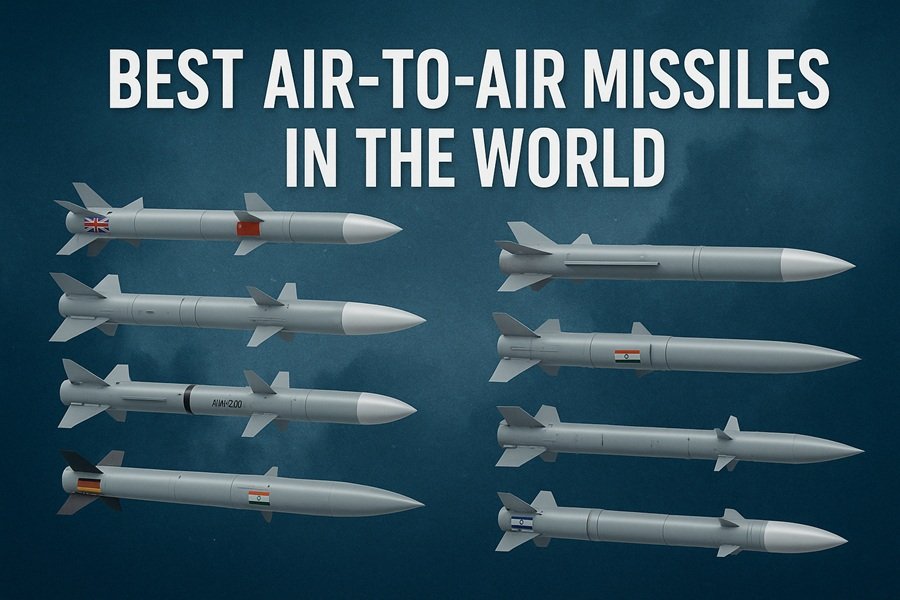
Introduction
In modern aerial warfare, air-to-air missiles (AAMs) define the effectiveness of fighter jets. Whether in dogfights or beyond visual range (BVR) engagements, the performance of these missiles can decide the outcome of conflicts.
This article explores the top 10 best air-to-air missiles in the world, categorized into BVR (Beyond Visual Range) and WVR (Within Visual Range) classes, based on range, seeker technology, speed, maneuverability, and combat performance.
Classification of Air-to-Air Missiles
| Type | Description |
|---|---|
| BVR Missiles | Engage targets beyond 30–40 km, typically radar-guided |
| WVR Missiles | Used in dogfights, rely on infrared (IR) homing |
| Dual-role Missiles | Capable of both BVR and WVR, often using advanced seekers |
Read This: BrahMos vs BrahMos-II
Best Air-to-Air Missiles (2025 Edition)
1. Meteor (MBDA – Europe)
- Type: BVR
- Range: 150–200+ km
- Speed: Mach 4+
- Guidance: Active Radar + Data Link
- Key Feature: Ramjet propulsion for extended no-escape zone
Why it’s the best: The Meteor missile has revolutionized air combat with its ramjet engine, providing consistent thrust and a large no-escape zone (~60+ km). It is currently the most advanced BVR missile in operational service.
Operators: UK, France, India (Rafale), Germany, Sweden, Saudi Arabia
2. PL-15 (China)
- Type: BVR
- Range: 200–300 km (estimated)
- Speed: Mach 4+
- Guidance: Active AESA radar seeker
- Key Feature: Allegedly longer range than Meteor
Why it’s feared: The PL-15 equips China’s J-20 stealth fighters and JF-17 Block III, posing a serious challenge to Western air dominance. Its range and AESA seeker make it extremely capable in high-tech environments.
Operators: China, Pakistan (upcoming), export in future
During the high-intensity engagement phase of Operation Sindoor in 2025, Pakistan reportedly deployed JF-17 Block III jets equipped with Chinese PL-15 missiles in an attempt to counter Indian air dominance.
Read This: https://bharatarticles.com/pl-15-vs-brahmos-a-detailed-comparison-and-operational-reality/
3. AIM-120D AMRAAM (Raytheon – USA)
- Type: BVR
- Range: ~160–180 km
- Speed: Mach 4
- Guidance: Active Radar + GPS Navigation
- Key Feature: Combat-proven, integrated with F-35, F-22
Why it stands out: The AIM-120D is the backbone of NATO air forces, with a proven combat track record. It is integrated on most Western fighters and continues to be upgraded.
Operators: USA, NATO, Japan, Australia, Israel, Saudi Arabia
4. AIM-260 JATM (USA – Upcoming)
- Type: BVR (6th Gen)
- Range: >200 km (classified)
- Speed: Likely Mach 5+
- Guidance: Advanced radar + AI coordination
- Key Feature: Designed to replace AIM-120D and counter PL-15
Future standard: The AIM-260 Joint Advanced Tactical Missile is the next-gen US missile to restore BVR superiority over Chinese systems. Deployment is expected by 2026–2027.
5. IRIS-T (Germany-led consortium)
- Type: WVR
- Range: ~25 km
- Speed: Mach 3+
- Guidance: Imaging Infrared (IIR) + LOAL
- Key Feature: Extreme off-boresight capability (90°+)
Why it excels: The IRIS-T is one of the world’s most agile short-range missiles, capable of post-launch lock-on and highly resistant to flares and countermeasures.
Operators: Germany, Sweden, Norway, Greece, Thailand, Saudi Arabia
6. ASRAAM (UK/India)
- Type: WVR
- Range: ~25–30 km
- Speed: Mach 3+
- Guidance: Imaging Infrared
- Key Feature: Longest range WVR missile, now integrated on Indian Su-30 MKIs
What makes it lethal: The Advanced Short-Range AAM blends range with dogfight performance. India’s integration of ASRAAM with Su-30MKI boosts its WVR capabilities significantly.
7. R-77-1 (Russia)
- Type: BVR
- Range: ~110–160 km
- Speed: Mach 4+
- Guidance: Active Radar
- Key Feature: Russian equivalent to AMRAAM
Why it’s important: Used on Su-30, Su-35, MiG-29, the R-77 series is the most commonly used BVR missile in the Russian Air Force and exports.
Operators: Russia, India (limited), Algeria, Vietnam
8. Python-5 (Israel)
- Type: Dual-role (WVR + short BVR)
- Range: ~20–25 km
- Speed: Mach 4
- Guidance: Imaging IR + Lock-On After Launch
- Key Feature: All-aspect engagement with counter-countermeasures
Combat advantage: Known for extreme maneuverability, high countermeasure resistance, and 360° engagement, the Python-5 is a staple of Israeli aerial dominance.
Operators: Israel, India, Brazil, Singapore
9. PL-10 (China)
- Type: WVR
- Range: ~20 km
- Speed: Mach 2.5–3
- Guidance: Imaging IR + Helmet Cueing
- Key Feature: Competes with IRIS-T and ASRAAM
China’s dogfight king: Integrated with J-10, J-16, J-20, the PL-10 is comparable to IRIS-T in performance and forms China’s WVR air defense core.
10. MICA NG (France – upcoming)
- Type: BVR + WVR
- Range: ~100–130 km (BVR), ~20 km (IR)
- Guidance: Dual variants (Radar & IR)
- Key Feature: Next-gen replacement for MICA
Future-proof: The MICA NG (New Generation) adds new seekers, propulsion, and countermeasure resistance. Will be key for Rafale F4 standard.
Summary Table
| Missile | Type | Range | Speed | Unique Feature |
|---|---|---|---|---|
| Meteor | BVR | 150–200+ km | Mach 4+ | Ramjet engine |
| PL-15 | BVR | 200–300 km | Mach 4+ | AESA seeker |
| AIM-120D | BVR | 160–180 km | Mach 4 | Combat-proven |
| AIM-260 | BVR | >200 km | Mach 5+ | AI-coordinated future system |
| IRIS-T | WVR | ~25 km | Mach 3+ | Extreme agility |
| ASRAAM | WVR | ~30 km | Mach 3+ | Long-range IR missile |
| R-77-1 | BVR | ~160 km | Mach 4 | Russian AMRAAM |
| Python-5 | WVR | ~25 km | Mach 4 | All-aspect strike |
| PL-10 | WVR | ~20 km | Mach 2.5–3 | Helmet cueing |
| MICA NG | Dual | ~130 km | Mach 4 | Multi-role missile |
Most Advanced Missiles by Category
- Best BVR: Meteor
- Longest Range: PL-15
- Best WVR: IRIS-T / Python-5
- Best Dual-role: MICA NG
- Future Dominator: AIM-260 JATM
India does have indigenous air-to-air missiles, and they’re becoming increasingly important in the Indian Air Force’s (IAF) arsenal. While many of the top-tier AAMs used by India are foreign (like Meteor, AIM-120, or R-77), India has made significant strides in developing its own air-to-air missiles, primarily through DRDO (Defence Research and Development Organisation).
🇮🇳 Indian Air-to-Air Missiles
1. Astra Mk-1
- Type: BVR
- Range: ~110 km
- Speed: Mach 4.5
- Guidance: Active Radar Homing
- Platform: Su-30MKI (in service), Mirage 2000, Tejas Mk1A (integration ongoing)
- Status: In production and service with IAF
Highlights:
India’s first indigenous BVR missile. Astra Mk-1 was tested successfully in multiple trials and has entered full-scale production.
2. Astra Mk-2 (Upcoming)
- Type: BVR
- Range: ~160 km+
- Status: Developmental trials ongoing
Highlights:
Extended range version of Astra Mk-1 with improved seeker and ECCM (Electronic Counter-Countermeasures). Will compete with AMRAAM and PL-15 class weapons.
3. Astra Mk-3 / SFDR (Solid Fuel Ducted Ramjet)
- Type: BVR with Ramjet (Meteor-class)
- Range: Estimated 300+ km
- Status: In development
Highlights:
India’s answer to Meteor and PL-15. The SFDR propulsion system provides sustained thrust, enabling large no-escape zones.
4. NGARM-DV / DRDO Infrared Missile (WVR)
- Type: WVR / IR-guided
- Status: In development (classified)
Note: India is also working on new-gen IR WVR missiles, but has so far relied on imported WVR missiles like R-73, ASRAAM, and Python-5 for short-range dogfight capabilities.
India’s Imported AAMs (in use or integrated)
| Missile | Type | Source | Platform |
|---|---|---|---|
| Meteor | BVR | France | Rafale |
| R-77 / RVV-AE | BVR | Russia | Su-30MKI, MiG-29 |
| ASRAAM | WVR | UK | Su-30MKI (India-specific integration) |
| Python-5 | WVR | Israel | Tejas Mk1A |
| R-73 | WVR | Russia | Su-30MKI, MiG-29 |
Summary: India’s AAM Capabilities
| Missile | Role | Origin | Status |
|---|---|---|---|
| Astra Mk-1 | BVR | India | In Service |
| Astra Mk-2 | BVR | India | Under development |
| SFDR / Astra Mk-3 | BVR (Ramjet) | India | R&D phase |
| WVR IR missile (Indigenous) | WVR | India | Planned |
| Meteor | BVR | France | In Service |
| ASRAAM | WVR | UK | Integrated |
| Python-5 | WVR | Israel | In Service |
Explore:
- F-35 vs Su-57 vs AMCA: Comparative Analysis of Next-Generation Stealth Fighters
- Tejas Mk1 vs Tejas Mk2: A Comprehensive Comparison of India’s Indigenous Fighter Jets
Conclusion
India is not dependent solely on foreign air-to-air missiles. With the Astra program and SFDR-based next-gen missiles, India is moving toward self-reliance in this critical area of aerial warfare. Within the next 5–7 years, India aims to field a fully indigenous AAM arsenal that can rival the best in the world.
The race for air dominance is increasingly about missile technology. As stealth aircraft proliferate and EW systems improve, air-to-air missiles must evolve to stay relevant. Missiles like the Meteor, and upcoming AIM-260 JATM are defining this future.






